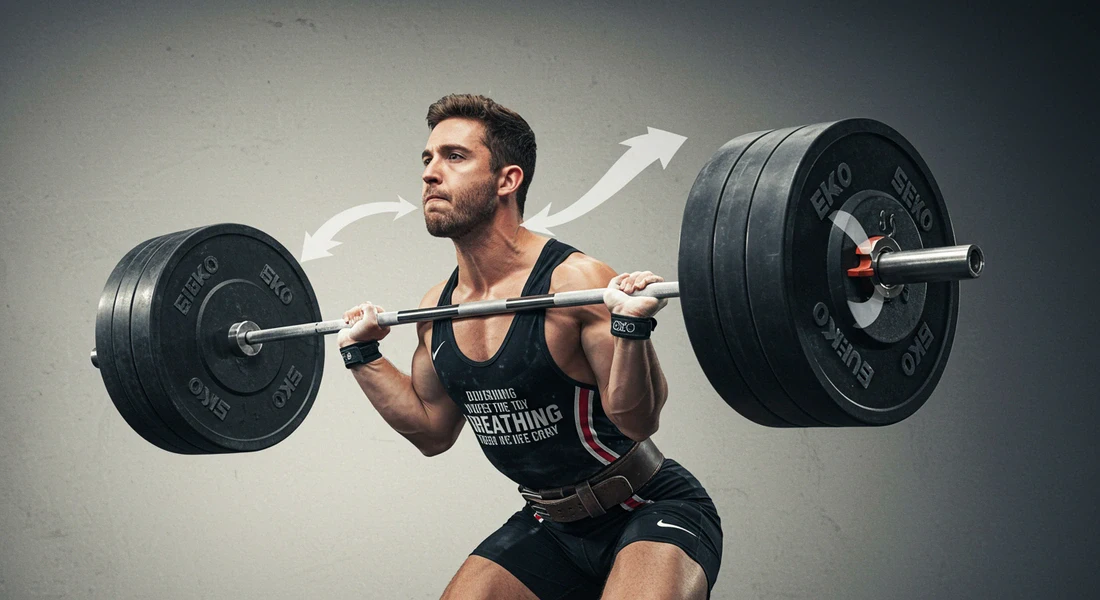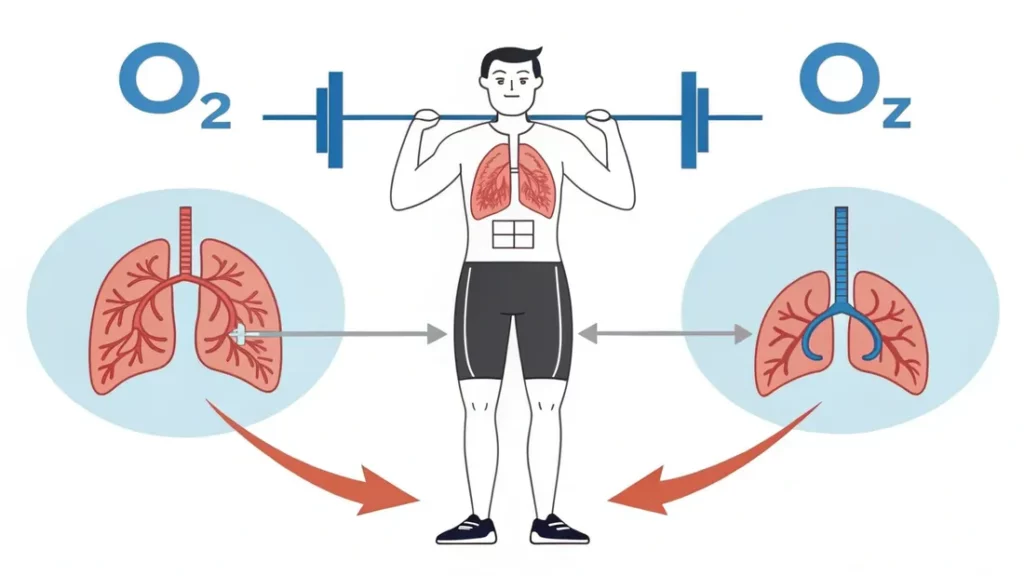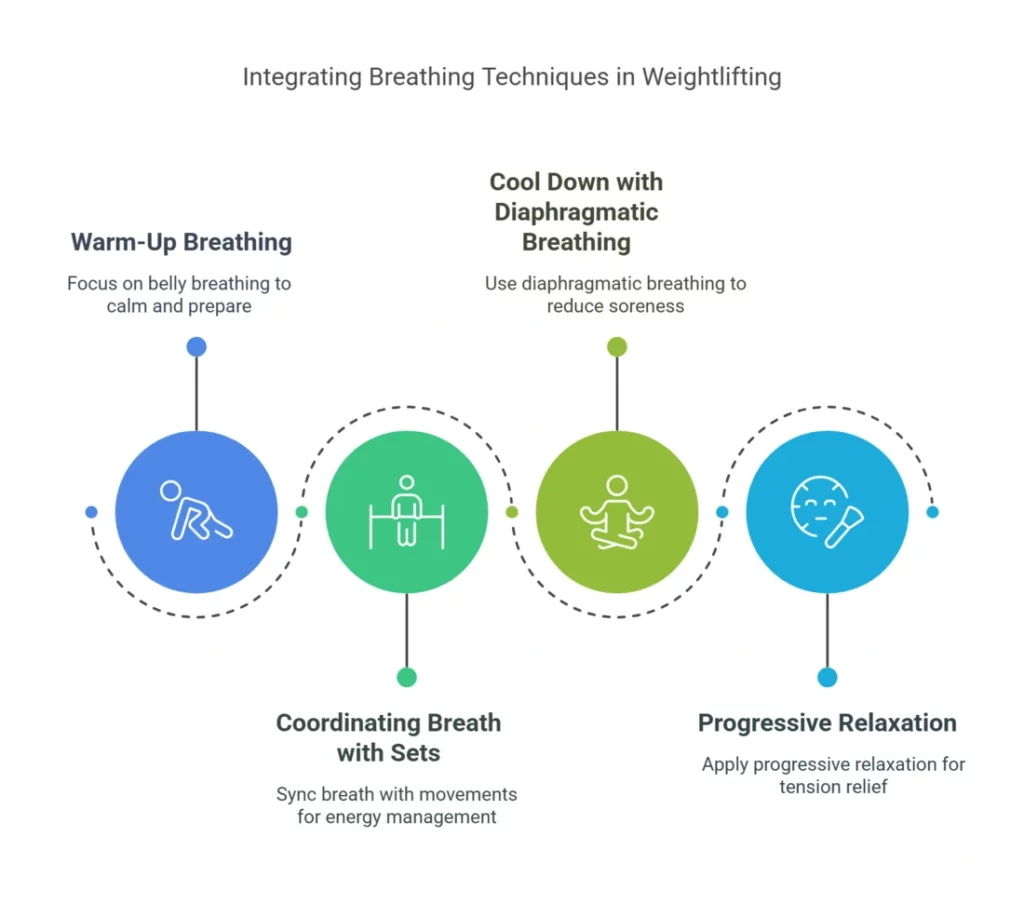Are you dedicated to pushing your limits in the gym, always striving to lift heavier and enhance your strength?
You may be overlooking one of the most powerful tools that can help you achieve these goals: the power of proper breathing.
The connection between breathing for weightlifting is often underestimated, but it is absolutely fundamental for maximizing your performance, and also enhancing your overall strength.

This is because the way you breathe directly affects the amount of power you have, the control you possess, and how well your muscles are able to recover.
In this comprehensive guide, we’ll be diving deep into the science of breathing and weightlifting, and also exploring specific techniques that you can use to take your training to the next level.
By implementing these methods, you will be well on your way to performing better, recovering quicker and achieving all of your fitness goals.
The Mechanics of Breathing and Weightlifting
To truly understand how breathing can enhance your strength during weightlifting, it’s important to explore the underlying mechanics.
Your body’s ability to effectively engage core muscles, deliver oxygen, and use energy is all heavily influenced by your method of breathing.
Let’s explore the core concepts of this link.

Key Concepts
- The Link Between Breathing and Core Stability:
- Breathing plays a crucial role in creating intra-abdominal pressure, which is what helps you to stabilize your core during weightlifting. This internal pressure helps to support your spine, and will also help to maintain proper form and balance throughout your movements. Your body’s stability is essential when lifting heavy weights, as it also reduces the risk of injury. Therefore, ensuring that your core is engaged, by using proper breathing is vital for a successful workout.
- By creating a more powerful core, you are also creating a stronger base, which will enhance your ability to move heavier weights and improve your overall performance.
- The Importance of Oxygen Supply for Muscles:
- During weightlifting, your muscles require a high level of oxygen for energy production and to enable them to contract effectively. The way you breathe has a direct impact on your ability to deliver oxygen to your muscles, and this is what will give you the ability to push yourself, to make muscle gains, and also to lift heavier weights.
- If you are not getting enough oxygen, your muscles will not be able to work as efficiently and effectively, which will hinder your overall strength. By implementing a correct breathing pattern, you are making your muscles work harder and smarter.
- The Effects of Poor Breathing:
- When you are performing weightlifting, and you are not breathing correctly, you will be negatively impacting your body. This method will lead to feelings of fatigue and breathlessness, but it also increases your muscle tension, and impacts your overall performance. By ensuring that you are using correct methods, you are also ensuring that you will have the stamina you need to push yourself to your limits, and to get the most out of your workout.
- Therefore, you must make a concerted effort to take control of your breath so that you can obtain the best results from your workouts.
Effective Breathing Techniques For Weightlifting
Now that you have a good understanding of how breathing impacts your workouts, let’s explore the specific techniques that can be implemented into your weightlifting routine.
These methods will allow you to maximize your strength, and also to improve your performance, overall.
Table: Breathing Techniques for Weightlifting
| Technique | How to Implement | Key Benefits | When to Use |
| The Valsalva Maneuver | Hold your breath briefly during the most challenging parts of an exercise, then exhale. | Strengthens your core, and provides spinal stability when lifting very heavy weights. | For moments of intense strain, when you are needing extra stability for heavy lifts. |
| Paced Breathing With Repetitions | Inhale during the eccentric (lowering) phase of the movement, and exhale during the concentric (lifting) phase. | Helps to manage energy levels, and also to enhance your focus. | Throughout all sets, when you are needing to manage your energy and focus during the activity. |
| Diaphragmatic Breathing | Take slow and deliberate breaths into your diaphragm, to ensure that you are fully engaging your lungs. | Helps to promote relaxation, and also to improve muscle recovery. | Can be used in between sets, or also during your cool down, when you are looking to improve your recovery. |
Physiological Benefits of Proper Breathing: Implementing these methods properly is vital as they ensure that your body is able to use oxygen effectively, and to remove waste products, such as carbon dioxide, in the most efficient way possible [https://www.ncbi.nlm.nih.gov/books/NBK54112/].
By using these breathing methods, you are supporting your body to perform at its best.
Techniques

- Technique 1: The Valsalva Maneuver
- Explanation: The Valsalva Maneuver involves holding your breath briefly while you are performing a challenging exercise. This process creates pressure in your abdominal cavity which helps to strengthen your core muscles and also improve spinal stability. It can be a useful tool when performing heavy lifts, and will help to ensure that you are stable and also safe.
- How to Implement: This method is not designed for regular use, and you should only use it for moments of intense strain when you need to create more core support. It is also important that you are not holding your breath for prolonged periods, as this will also prevent the necessary blood flow and oxygen from reaching your muscles.
- Technique 2: Paced Breathing With Repetitions
- Explanation: Paced breathing involves coordinating your breath with your movements while performing each rep. When you are lifting a weight, inhale during the eccentric phase, (when the weight is being lowered), and exhale during the concentric phase (when you are pushing the weight). This rhythmic breathing pattern helps to manage your energy and to also enhance your focus.
- By pacing your breath, you are also making sure that you are breathing at the right moment, to ensure that you are getting the most out of each rep and your overall set.
- How to Implement: You can easily implement this method by counting your breaths in each set, and making sure that you are synchronizing the way you breathe with how you are moving.
- Technique 3: Diaphragmatic Breathing During Recovery
- Explanation: After completing your sets, it is vital to ensure your body is in a state of calm, so that it can begin to repair. Diaphragmatic breathing, also known as belly breathing, is a method that involves using your diaphragm to fully engage your lungs, which can have a calming effect and also assist in muscle recovery.
- By performing this method, you will reduce your stress levels, and also allow your muscles to heal and reduce any feelings of soreness.
- How to Implement: You can use belly breathing in between your sets, or you can also add it as part of your cool-down routine, to enhance your overall experience, and also assist with your long-term recovery.
How to Implement Breathing into Your Weightlifting Routine
Now that you have a solid understanding of some of the best breathing techniques for weightlifting, let’s explore how you can start implementing them in your training routine.
The key to success is consistency, so be sure to approach this with patience, and also mindfulness.

Key Implementation Strategies
- Warm-Up:
- During your warm-up, take a few minutes to focus on belly breathing. This will help you to calm your mind, and prepare your body for the workout ahead. It will also help you to connect with your body and become more aware of how you are feeling.
- Focusing on your breath during the warm-up will also help you to have a more effective workout as it will prepare you both mentally and physically.
- During Sets:
- While you are performing your weightlifting sets, try to focus on coordinating your breath with each movement. Paced breathing is a great option for this, as it allows you to work in a more controlled and effective way. If you are doing heavy lifts, remember to use the Valsalva maneuver, but ensure that you do not hold your breath for too long.
- Using breath control while weightlifting will help you to manage your energy and also to make the most of your strength. The method you use will entirely depend on your workout goals and your experience level. Remember to always listen to your body, and do what feels right for you.
- Cool Down:
- As you finish up with your sets, remember to spend some time cooling down with a relaxing method such as diaphragmatic breathing. This will help to reduce muscle soreness, and also to improve your recovery time. By implementing this, you are making sure that your body and your mind are able to unwind, which will help you to have a better workout experience.
- If you feel like you have any tension in your body, you should also implement a method such as progressive relaxation to further enhance your relaxation journey.
Practical Tips For Breathing During Weightlifting
Implementing proper breathing techniques into your weightlifting routine is a skill that takes time and dedication.
To help guide you on your journey, here are some practical tips to keep in mind.
Remember that these tips are designed to empower you, and to give you the freedom to make the most of your workouts.
Key Tips
- Start Gradually:
- When you are first implementing these breathing methods into your weightlifting routine, make sure to start gradually. Do not overwhelm yourself, and instead, focus on making small changes that will slowly build up over time.
- If you start with just a single technique, this will allow you to familiarize yourself with it, and will also help you to feel more confident. This approach is far more sustainable, and will help you to achieve long-term results.
- Be Consistent:
- Consistency is the key to success for all aspects of fitness, and is especially useful when you are trying to change the way you breathe. Ensure that you are using these methods regularly, and that you are making a conscious effort to incorporate them into every workout session.
- Try to make breathing part of your daily routine, so that it is second nature, rather than a task you need to focus on completing.
- Focus on Proper Form:
- When you are performing weightlifting, it is essential to ensure you are not compromising your form. Poor form can also lead to injury, so it is best to remain focused and also to pay attention to your breathing as you are lifting your weights.
- Proper form and proper breathing work hand in hand to ensure you are getting the most out of each rep, and every set, without causing your body any damage.
- Listen To Your Body:
- Remember to always listen to your body and also to be aware of how you are feeling. If something feels uncomfortable, or you are experiencing pain, then it is essential that you stop and take a break. Do not try to push your body to its limits, if it is not ready.
- You should prioritize your overall health and well-being above all else, and to also understand that there will be times when you will need to take a break. This is perfectly normal, and should be part of your routine.
Frequently Asked Questions About Breathing for Weightlifting
To help address any other questions you may have, I have compiled a list of frequently asked questions about breathing for weightlifting.
By answering these, you will have a more thorough understanding of the importance of breathing for your workout routine, and be fully equipped with all the necessary knowledge to implement these changes into your daily life.
- Question 1: How should you breathe when lifting weights?
- Answer: When you are lifting weights, it is important to make sure that you are breathing consistently and also using the best method for your specific routine. Use paced breathing to coordinate your breaths with your movements. Remember to inhale as you are lowering the weight (eccentric phase), and to exhale as you are lifting it (concentric phase). This will help you to better understand how to make the most out of each movement.
- Question 2: Is it bad to hold your breath when lifting?
- Answer: Yes, holding your breath should be avoided where possible, as this limits your oxygen intake, which can cause muscle fatigue and may also lead to an increase in blood pressure and tension in your body. However, in specific scenarios, you may need to briefly hold your breath to get the extra stability required to lift very heavy weights, which is a method known as the Valsalva Maneuver. However, this should not be done for extended periods of time.
- Question 3: What is the best method for breathing during squats?
- Answer: For squats, a combination of both paced breathing and diaphragmatic breathing is the most useful. This can help you to maintain focus throughout the movement, whilst also engaging your core, and ensuring that you have enough oxygen to perform. During your recovery, be sure to use methods such as belly breathing to bring your body back to a state of relaxation.
- Question 4: How can breathing techniques improve your strength?
- Answer: Breathing techniques such as paced breathing and diaphragmatic breathing help to improve your strength by enhancing your overall breathing efficiency, which increases your muscle performance, reduces fatigue, and also provides you with better energy management. They also help to improve core strength, which is vital for lifting heavy weights. By incorporating these techniques into your routine, you are well on your way to a better workout journey.
My Final Thoughts On Breathing For Weightlifting
As we conclude this comprehensive guide, I hope you now understand the vital connection between breathing and weightlifting, and also how it can help you to achieve all of your fitness goals.
It is more than just something that your body does to stay alive, it is a powerful tool, that can be used to further your performance.
In this post, we have explored the underlying mechanics of breathing, and how this relates to weightlifting, including the importance of oxygen delivery, core strength, and also energy management.
We also explored specific methods that you can use to enhance your workouts, such as the Valsalva Maneuver, paced breathing, and diaphragmatic breathing.
By now you should have a good understanding of these methods, and also how to use them in your daily life.
I encourage you to start implementing these methods today, and to begin experimenting with all of the different techniques to find what works best for you.
Remember that consistency and patience are key, so do not get disheartened if you do not feel the changes immediately.
There is a whole world of breathing techniques out there to explore, and I hope that this post has encouraged you to delve into this world, and to see what it has to offer.
Now, go forth and breathe!
Related Posts
No posts
